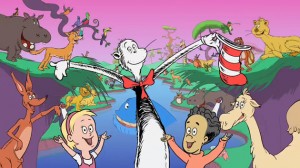
Cat in the Hat Knows a Lot About That! was one of several PBS Kids videos and games used in the study.
One of the nagging issues game designers continue to face is how can they prove using a game to learn is more effective than reading a book or watching a video. A new survey of PBS pre-school math program appears to answer that challenge.
The rigorous study of more than 92 classrooms found that using a structured mix of games, handouts and digital tools boosted math ability among four- and five-year-olds.
“The important skills measured—counting; subitizing; recognizing numerals; recognizing, composing, and representing shapes; and patterning—increased significantly for the study’s four- and five-year-old children, who were from traditionally economically disadvantaged communities where children are often less prepared for kindergarten than are their more socially and economically advantaged peers,” wrote the study’s authors.
The survey was done by Education Development Center (EDC) and SRI and was part of PBS’s larger Ready to Learn initiative that is funded by the U.S. Department of Education.
Key Findings
- Students who used the PBS Kids content did 9 percentage points better.
- The PBS students did better compared to those students who had access to the same technology, but not the PBS content.
- Pre-school teachers came away with a much higher degree of support for using games in the classroom after seeing the PBS Kids content in action.
The research exposed the children, who primarily came from poorer and more diverse sections of New York and San Francisco, to games and videos from Sid the Science Kid, The Cat in the Hat Knows a Lot About That!, Curious George, and Dinosaur Train, as well as non-digital activities including books and foam shapes, designed to support the growth of math understanding.
“In other words, kids learned math and teachers grew more confident teaching math, which is what one would expect to happen when classrooms are equipped with high-end technologies, such as interactive whiteboards and laptop computers, and when teachers are encouraged to use high-quality free content,” EDC’s Shelley Pasnik, vice president and director of the Center for Children and Technology, wrote last week on the Joan Ganz Cooney Center blog.
The study did seem to offer the most hope for how technology mixed with a concrete teaching plan and learning tools can assist even the students who struggle the most with math, concluding, “Digital transmedia can advance content-area learning for young children, and may be of greatest value for those children who are most in need of academic support.”
